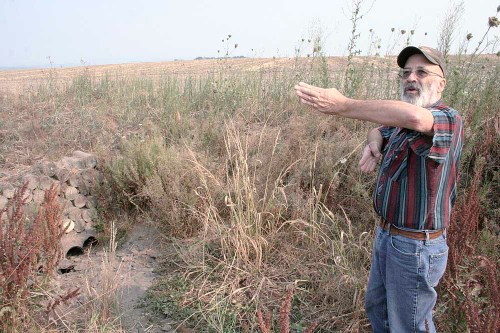Ditch-cleaning bill passes, but Brown has yet to sign it
Published 10:30 am Thursday, July 18, 2019

- Farmer John Scharf explains the drainage of tile lines from his fields near Amity into a ditch. A compromise bill passed by the Legislature would allow farmers to clean out ditches more easily.
SALEM — A proposal to streamline ditch-cleaning regulations got in just under the wire to win approval from Oregon lawmakers, though farmers will likely wait another year to use the program.
Growers would be allowed to remove up to 3,000 cubic yards of dirt per mile of ditch over five years without a state fill-removal permit under House Bill 2437, up from 50 cubic yards per year under existing law.
Trending
The bill’s fate was uncertain as Republican senators walked out to prevent a vote on a controversial climate bill toward the end of the legislative session.
However, they returned in time for the Senate to vote 18-9 in favor of HB 2437 on June 29, the day before the Legislature adjourned for the year. The bill had already passed the House 42-17 about two weeks earlier.
The bill continues to face opposition from some environmental groups, which would welcome a veto from Gov. Kate Brown. The governor has until Aug. 9 to decide whether to sign the bill.
“From our point of view, this bill takes things back decades as far as wetland protection,” said Kimberley Priestley, senior policy analyst for the Waterwatch of Oregon nonprofit.
Farmers who clean ditches under the program would first have to notify the Oregon Department of Agriculture of their plans, which would be reviewed by the Oregon Department of Fish and Wildlife.
Work could only take place during the dry season and the streamlined rules would not apply to essential salmonid habitat.
Trending
Opponents of the bill worry about the unintended consequences of removing a much larger quantity of sediment from ditches, as well as the effect of depositing the material in wetlands, said Priestley.
They’re also troubled by the lack of public notice for proposed ditch-cleaning.
“I think there are citizens across the state that are interested in these types of projects,” she said.
If the bill is signed into law, it doesn’t go into effect until January 2020. Implementing the new rules will also require a memorandum of understanding between ODA and the Oregon Department of State Lands, which oversees fill-removal permits.
The two agencies will decide whether additional rule-making is necessary to implement the bill and there is no timeline for when the new regulations will become operational, said Meliah Masiba, legislative coordinator for DSL.
The bill’s language is comprehensive enough that rule-making may not be necessary, said Mary Anne Cooper, vice president of public policy for the Oregon Farm Bureau.
Even so, it’s likely that farmers will have to wait until next spring to provide notices and the following summer or autumn to clean ditches under the program, Cooper said.
The Farm Bureau will be keeping an eye on the program’s progress as it’s implemented.
“Our number one priority is ease of use for farmers,” Cooper said.









